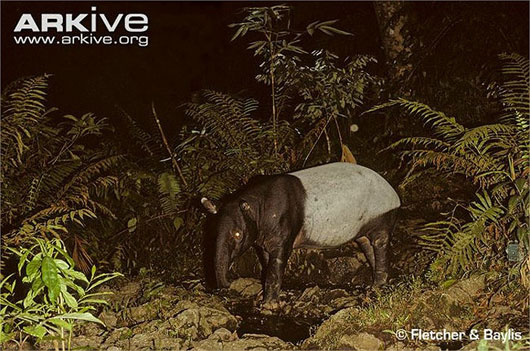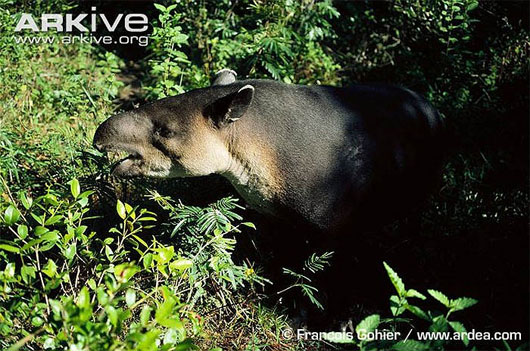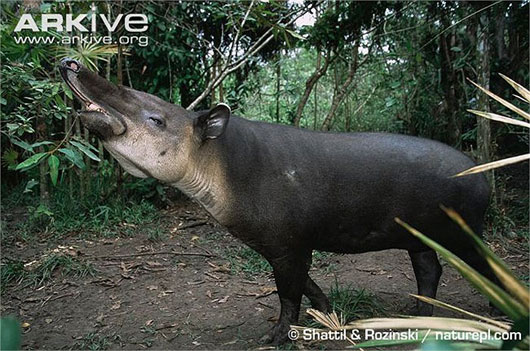Outlandish pig fauna comes from ancient times
In Malaysia, there is a pretty strange pig species, with a short hose like an elephant. They are called pig taps. Tapirs are of the Tapiridae family, the only genus Tapirus. They are a group of 4 species, large in size, shaped like pigs, but have taps.
>>>The pig monster has an odd appearance in Indonesia
They live in Malaysia. Several other proboscis pigs are also present in the rainforest areas of South America and Central America. Around the world, there are four tapirs, all listed in the red book, classified as endangered.

Their close relatives are other odd-toed ungulates such as horses or rhinos. Tapirs are considered ancient animals. Scientists found fossil pig fossils from 55 million years ago. Over the past 55 million years, they have almost no change in shape.
Odd animals, including tapirs, have become the dominant group among land-dwelling animals that eat leaves during the Oligocene. It is believed that Asian and American tapirs have branched around 20 to 30 million years ago and that American tapirs have moved from North America to Central and South America about 3 million years ago.

Tapirs are very large species in the pig family. They are 2m long, 1m tall, weigh up to 300kg, even 500kg. The tap of a tap is a highly flexible structure that can move in all directions, allowing them to take leaves in difficult locations.
The length of the hose varies according to the species. Malaysian tapirs have the longest hose and Brazilian tapirs with the shortest taps. Although the taste of tapirs is very poor, even blindness comes into the sun, however, hearing and smell develop strongly.

Tapirs reach sexual maturity at about 3-5 years of age. Healthy female piglets give birth 2 years a litter. The gestation period of a female pig is up to 13 months. The natural lifespan of pigs is about 25-30 years, both in nature and in the zoo.
Surprisingly, tapirs are very sympathetic species. In their whole life, there is only one mate, even though it is only in time to mate them next to each other. Surprisingly, tapirs are very sympathetic species. In their whole life, there is only one mate, even though it is only in time to mate them next to each other.

Although living in dry forests, tapirs also often immerse themselves in water, eat soft grasses, seek shelter from enemies as well as cool the body. Tapirs near water sources will swim, dive to the bottom and walk along the riverbed to feed, as well as dive into the water so small fish catch parasites from their massive bodies.

In addition to wading, the tapirs also often immerse themselves in mud pools, helping them cool and eliminate insects on the body. Tapirs prefer to eat fruits, leaves, especially young and soft leaves. Each day, they eat up to 40kg of food. They mainly go to feed at night or at sunset.
Although they are gentle animals, other animals are difficult to bully them, because they have thick skin on their backs and necks, protecting them from jaguars, crocodiles, pythons and tigers.

However, hunting for meat and skin has significantly reduced the number of tapirs and, more recently, the loss of habitat has caused the pigs to be listed on the endangered list.
- Raising children in ancient times
- UFO appeared since ancient times?
- Sex in ancient times
- The horrifying facts about condoms in ancient times
- Finding toys in ancient times
- Close up of ancient frogs only in Vietnam
- Lipsticks from the female toxins of ancient times
- Flora and fauna extinction: Alarming disasters for humans
- Egyptian mummy revealed the pollution in ancient times
- Unique, peculiar contraceptives from ancient times to modern times
- Ancient people have known how to use calendars since ancient times
- Cats have been domesticated since ancient times
 Animal 'suffering' after hibernation
Animal 'suffering' after hibernation Why do goats climb well?
Why do goats climb well? Scientists were surprised to see chimpanzees eating turtles
Scientists were surprised to see chimpanzees eating turtles Giant catfish died deadly due to drought in Thailand
Giant catfish died deadly due to drought in Thailand